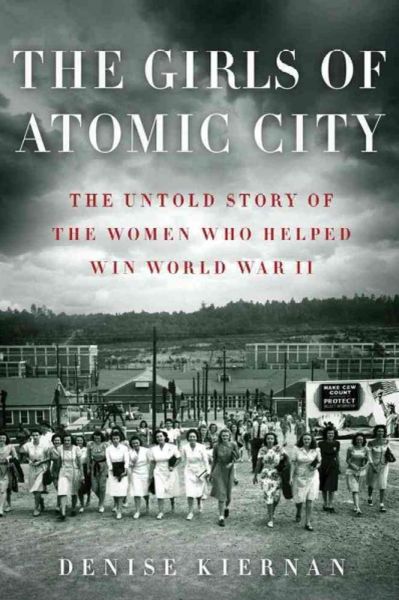Trust the US to turn procuring weapons of mass destruction into something sordid
The Girls of Atomic City: The Untold Story of the Women Who Helped Win World War II
By Denise Kiernan

18 Oct, 2014
0 comments
While accounts of the development of the atomic bomb will mention women like Lise Meitner and perhaps Ida Noddack in passing, for the most part the story of how the atomic bomb came to be is framed as a male one. In fact, there were were thousands of women, blue collar and white collar, involved in the Manhattan District. In Girls of Atomic City, author Denise Kiernan tries to cast a little light on groups generally consigned to the shadows.
Oak Ridge was built on seized land amounting to a seventh of Anderson County, its creation mandated by the demands of the Manhattan District and the peculiar advantages the location offered. In 1940, Oak Ridge was populated by a handful of people. Between Fall of 1942 and late Summer of 1945, that number would swell to 75,000 people. Those 75,000 people came from across America and it is not surprising that Oak Ridge reflected all the strengths and weakness of wartime America, magnificent resources focused on an audacious project often sabotaged by paranoia and destructive social prejudices.
Kiernan selected nine women out of Oak Ridge’s multitudes as her principal figures: two secretaries, a statistician, a chemist, a janitor, a pipe-inspector, two calutron operators, and a nurse. The wartime project was careful to keep people sequestered so that only a select few – those in charge, the battalions of Soviet spies, and so on — had a view of the whole picture, even going so far, or so rumour said, to hire illiterate Gullahs as cleaning because they could be relied on not to read secret documents. By following the lives of a diverse group of women Kiernan created her own big picture. Some parts of this picture as sunny as possible for anything whose punch line is “and then one hundred thousand Japanese caught fire” but others are of a darker nature.
There is a pleasant fable about how World War Two brought people together and while some did sacrifice in the name of the greater good, it was just as common to see people and organizations handicapping the war effort to preserve peace-time prerogatives. Certain professions were reserved as male domains and women who could have excelled in those fields were consigned to specializations the men did not care so much about. One of the reasons Oak Ridge was willing to hire women was because of the low status of women; girls right out of high school could be more easily controlled than men or so it was believed.
While the treatment of the women in general was often deplorable, it’s the pointless abuse heaped on the African-Americans that really caught my eye. It’s not surprising to see segregated housing in an American community in this time and place and the insistence that the African-Americans didn’t even want nice homes is, sadly, just the kind of self-deluded twaddle one would expect from the upper castes in America. The twist where the authorities then segregated the African-American worker accommodations by sex so that spouses could have no contact with each other was just the sort of needless spite I should have expected but didn’t.
The Allies were somewhat fortunate in facing an enemy that was truly monstrous because Axis outrages draw attention from Allied abuses; compared to the Three Alls or Buchenwald, Executive Order 9066 doesn’t look so bad. That said, Oak Ridge did give Unit 731 a run for its money with the Ebb Cade case. Cade was an African-American who had the misfortune to be injured enough to require medical aid and healthy enough to serve as an involuntary medical subject. The exact behavior of plutonium in the human body was not well known at this time and since Cade was handy, the doctors simply injected him with plutonium to see what would happen[1]. To their irritation, what actually happened was Cade, perhaps suspicious about their intentions, quietly left the hospital unnoticed.
The women at Oak Ridge were not generally lauded for their contribution to the war effort and many of them would have been driven out of professional work and back to the kitchen following the war. While Oak Ridge provided opportunities not available elsewhere, the intention was to create a nuclear device, not to help women better themselves. Those who did enjoy success outside the domestic sphere did so largely due to their own efforts, often in the face of overt hostility and entrenched sexism.
My only complaint about this book is that I would have liked something more along the lines of a tome. I would imagine the author was somewhat limited by the fact many of the women who worked at Oak Ridge as part of the Manhattan Project are too dead to be interviewed (whether anyone bothered to present the women’s eye views of Oak Ridge in the forms of diaries and letters, I would not know) and also by the constraints the publishing industry places on works of general-audience non-fiction. Otherwise, I thought this well worth my time.
The Girls of Atomic City may be purchased from a number of sources.
- In the researchers’ defense, medical research that inflicted enhanced mortality on African-Americans without their consent was perfectly acceptable practice right up to the 1970s, if not later, as conventional as beating a disobedient wife. To the Americans’ credit, once the groups normally targeted for inhumane medical exploitation got greater access to the machinery of democracy, the powers that be grudgingly feigned regret, at least in a few cases. Of course, that was about two generations after Cabe made his escape.
